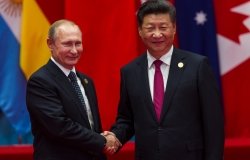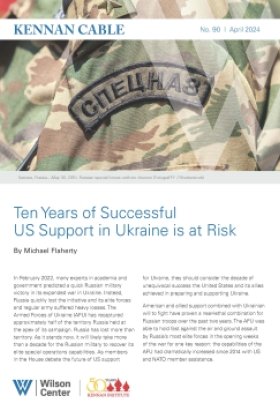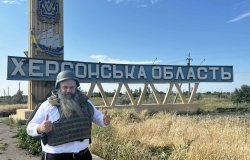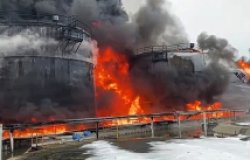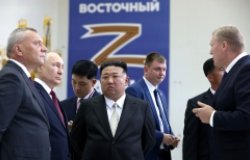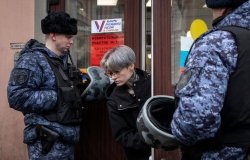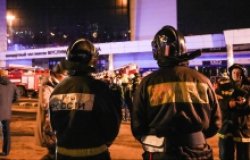Moscow 1941: A City and Its People at War
Rodric Braithwaite, former British Ambassador to the Soviet Union/Russian Federation, and Public Policy Scholar, Woodrow Wilson Center
Overview
At a recent Kennan Institute talk, Rodric Braithwaite, former British Ambassador to the Soviet Union/Russian Federation, and Public Policy Scholar, Woodrow Wilson Center, described the situation in Moscow during the German invasion of the Soviet Union in World War II, drawing on the interviews and other research he has done for a forthcoming book on Moscow in 1941.
German military leaders had seriously underestimated the Soviet army, assuming that German forces would defeat the Soviet army as quickly as they had defeated the French army. In fact, the German army faced substantial and increasing resistance as they marched on Moscow. The Nazi forces eventually reached the outskirts of the city, but were driven away by the end of 1941.
In June 1941, the Soviet Union had the world's largest army and air force, and more tanks (including some vehicles better than anything the Germans could put against them) than the whole of the rest of the world put together. It was nevertheless severely defeated in the initial battles, partly because it was halfway through a massive program of re-equipment and expansion, and partly because it was still demoralized from the prewar purges. Moreover, in a classical intelligence failure with parallels in other countries at other times, Stalin had refused to draw conclusions from the overwhelming intelligence available to him of an impending German attack.
The response of people in Moscow to the German attack was a flood of volunteers. People came from the intelligentsia, from the factories, and from the schools. They included substantial numbers of women, who served as everything from nurses to pilots to snipers. Twelve volunteer divisions were formed, who suffered such large losses in the battle for Moscow in October 1941 that five had to be disbanded. People still believe that these volunteers were sent into the field unarmed and unprepared. In reality, most of them did have uniforms, weapons, and some training, and were little worse off than the soldiers in the regular army, who in 1941 were also ill equipped and trained. In the first six months of the war about 2.5 million Soviet soldiers were taken prisoner, nearly 700,000 of them before Moscow. Many of these had died by the end of the year from German neglect.
In the middle of October 1941, Stalin ordered that the government be evacuated from Moscow. The evacuation created a panic in the city. Factories and offices were shut down with no explanation given to employees. There were riots and looting, and some rioters called out pro-Nazi slogans. Stalin responded by remaining in Moscow, halting the evacuation, providing workers with food and cash, and using the NKVD to restore order. Even today people in Moscow prefer not to talk about these events, though most of the relevant documents have now been published.
Against the advice of his generals, when the Germans were little more than fifty miles from Moscow, Stalin held a military parade in Red Square on November 7 to mark the anniversary of the Bolshevik Revolution. The parade had a tremendous impact on morale in Moscow and throughout the Soviet Union. Stalin's willingness to take such a risk reflects the positive side of his role as a leader of the nation in war, just as his failure to prepare for the German attack in June reflects the negative side.
Living conditions in Moscow during the fall and winter of 1941 were terrible. Conditions in Moscow were never as dire as they were during the siege of Leningrad, but food supplies, sanitation and heating were all on the verge of breakdown. There was malnutrition and disease. Nevertheless, the cultural life of the city continued even as battles raged on the outskirts of the city.
In December 1941 the Russians counter-attacked and inflicted a severe defeat on the Germans, the first and one of the most significant they suffered during the Second World War. Even after D Day, two thirds of the German forces were engaged on the Eastern front, and that is where they suffered more than four fifths of their casualties. Soviet losses in the battle of Moscow alone exceeded British losses during the whole of the First World War, and equaled the combined losses of the British, French and Americans during the whole of the Second World War. Overall, for every Briton or American lost in the Second World War, the Soviets lost eighty three people. Russians resent what they perceive as a failure in the West to recognize the extent of their losses and the crucial contribution they made to the common victory over Nazism.
Hosted By

Kennan Institute
The Kennan Institute is the premier US center for advanced research on Russia and Eurasia and the oldest and largest regional program at the Woodrow Wilson International Center for Scholars. The Kennan Institute is committed to improving American understanding of Russia, Ukraine, Central Asia, the Caucasus, and the surrounding region though research and exchange. Read more
Thank you for your interest in this event. Please send any feedback or questions to our Events staff.
